- Home
- Gary Vaynerchuk
Crushing It! EPB Page 4
Crushing It! EPB Read online
Page 4
What Lewis did have, thanks to his athletic training, was a belief in himself. He started pondering the question, “What could I create if I could create anything in the world?” He already knew what it felt like to get paid to do something he loved, so there was no question of taking any old corporate job he could get. But he needed to do something, because after so many months of living on her couch rent free, his sister was getting impatient.
A mentor suggested he get on LinkedIn. Lewis realized that the platform gave him direct access to lots of successful people, people who might be able to lead him to opportunities or at least explain to him how they had gotten to where they were.
“All I ever wanted to do was be around inspiring people that I could learn from.” He spent the next year, eight hours or so a day, connecting with local business leaders, inviting them to lunch and conducting informational interviews to learn more about how they’d achieved their success. Thinking he might be a natural fit for a job in the sports world, he’d at first reached out to a number of sports executives. As one person connected him to another person, who then suggested he meet with another, his circle grew wider. As he learned more about LinkedIn’s possibilities, he optimized his profile, which then led to bigger and bigger influencers agreeing to meet with him. By the end of 2009, he had thirty-five thousand connections.
At the time, Tweetups—in-person gatherings of Twitter users around a common cause—were a popular networking venue.
“I went to a couple and I thought, Hmmm, I’m building this following on LinkedIn. Why don’t I do a LinkedIn meetup?” So he did one in St. Louis, where he had once gone to private boarding school. Three hundred fifty people attended, and thanks to selling a few sponsorship tables, he earned about a thousand dollars.
“So I was like, Hmmm, why don’t I see if I can do another event and charge five dollars at the door?” He did, and he made money off the entry fee as well as the sponsorships.
“And then I was like, Hmmm, I’m building a relationship with these venues. What if I asked for a 10 percent commission on the food and bar sales from these networking events?” They said yes.
In short order, Lewis was bringing in a couple thousand dollars a month, enough to finally get off his sister’s couch and move into his own apartment, the cheapest one he could find, a little one-bedroom for $495 per month in Columbus, Ohio.
People were astounded. How was he pulling this off? He didn’t have a real job, he didn’t have a college degree, and yet he was bringing big influencers together all over the country and being asked to speak at conferences. All through LinkedIn. They started asking if he could show them how to use the platform for their businesses, too. And Lewis thought, Hmmm.
Lewis started teaching other entrepreneurs and businesspeople how to optimize their profile and reach out to potential clients, investors, or whomever they needed.
“I think because I came with energy and passion, I attracted opportunities. I attracted people to come to these events. I became passionate about teaching, because no one else was talking about LinkedIn the way I was. I made it fun when LinkedIn is very boring for a lot of people.”
Not long afterward, he found out that an entrepreneur named Gary Vaynerchuk would be having a signing for his new book, Crush It!, in St. Louis. Lewis reached out and offered to help promote the event on LinkedIn.* Given that he was helping promote the book, it made sense to read it. It was a long time ago, and he remembers very few of the details today, except for one chapter: Care.
I never felt like I was smart. I never felt like I had the intelligence, or the skills, or the experience, or the credentials. I didn’t have any of that. So when I read that word, I thought, Yes! I needed to continue to deepen my level of care! When I would meet with these influencers, I would never ask for advice. I would just say, “I’m so curious to hear your story about how you became successful.” And at the end of that I would say, “What’s the biggest challenge you have in your business, or your career, or your life right now?” and listen. And they would tell me everything they needed. I said, “You need a sales guy? I’ve got three of the top ones right here. You need a programmer? I’ve got this person. You need a designer? I met one last week. He was great.” I just became this connector to all the most successful people. I never asked for a job. I never asked for business. That one-word chapter confirmed that when we show up and we add value and we care, then we can learn how to make money around it later. But show up with value first. That is how I built the last decade of my life.
Lewis was already teaching himself to be entrepreneurial and making a little money, but now, inspired, he really put on the gas. Crush It! said you had to be niche, so he decided he wasn’t going to be “the social-media guy” like everyone else in 2008–2009; he was going to be the LinkedIn guy. Crush It! said work fifteen-to-sixteen-hour days, so that’s what he did. “I was working my ass off.” He built up his expertise until every social-media conference was booking him as the LinkedIn speaker. He also got creative.
I started approaching venues, which were mostly restaurants and bars, and built a relationship with either the manager or the owner. I’d try thinking about how I could make my event valuable for them. How could I care for their biggest need, their biggest challenges? So I started asking, “What is the night you make the least amount of money?” And they would answer “Tuesday night” or “Wednesday night” or whatever it was, and I’d say, “OK. I’m going to bring you five hundred people on that night, because I want to make every night a profitable night for you, not just the weekends. And I’m going to bring new business leaders, a new audience of quality people to your business.”
Lewis did, and what was once these venues’ worst night became their biggest night. From then on, they were willing to let Lewis host events any time he asked. He did, but he also started taking bigger risks.
“I just started to go for it and ask for what I wanted, even if I thought it wasn’t going to work. I started asking for 20 percent commission off food and bar, as opposed to 10 percent. I charged twenty dollars at the door instead of five. And I started charging more for sponsorships.”
Because Lewis was bringing so much value to the venues, the sponsors, and the event attendees, all were more than happy to pay a higher price for Lewis’s services. In one year, he hosted twenty events around the country.
He branched out into other service products, and in two years, the company was bringing in over $2.5 million in sales. But despite the success, after a few years, Lewis was ready to do something new. “I became less passionate. There’s only so much I can talk about how to add the right photograph and optimize your LinkedIn profile.” He sold his business and got started on his next project, School of Greatness, a podcast that shares inspiring stories, messages, and practical advice from some of the biggest athletes, celebrities, and business minds in the world.
Since its inception in 2013, School of Greatness has been downloaded tens of millions of times and makes a regular appearance in the iTunes podcast Top 50. In 2015, Lewis published his New York Times best seller, The School of Greatness. He continues to coach, attend speaking events, and contribute articles to major media outlets. And while Lewis still loves and uses LinkedIn, he has also focused his efforts on other platforms that drive the most traffic, downloads, and sales and help him continue to build his audience. At this point, the only thing holding him back is that he’s just one man, so he has hired a stellar team to help him run all aspects of the business, from podcast editing to Facebook ads to customer support.
“I feel like the luckiest guy in the world. I had to learn the skills I needed and become competent enough to match my confidence, but the thing that surprises me the most is learning that it’s not about how much you know; it’s about how much you care. We can create anything we want to if we have the passion, the energy, the hustle, and commitment to our vision. If I had been a jerk all along the way and I didn’t care about people, there’s no chance I would have been
able to do this. If you show up with that energy and intensity every single day, good things are going to happen.
Authenticity
Your intent will be reflected in your authenticity. You will be a thousand times more successful if you wake up eager to share and create something because you believe the world will enjoy it rather than because you have calculated that this is what you need to do to become an Instagram celebrity. Authenticity is a welcome relief to consumers who live in a society where they constantly feel that they’re being taken advantage of or hearing only parts of the whole story. Don’t try to fake it. Eventually you’ll be shown for who you are. Instead, figure out how to use the modern platforms—Instagram, Snapchat, YouTube, and all the others we’ll cover in this book—to give away that good stuff you’ve got, whether it’s your incredible fashion sense, your hilarious brand of comedy, your innovative team-building strategies, or your stunning flower-arrangement ideas. Figure out the best platforms to showcase your true self, your craft, your joy, and your love for what you do. The more authentic you are, the more people will be willing to forgive your inevitable mistakes and stumbles.
I mentioned above that a good chunk of my audience is converts, people who thought I was just a blowhard until they realized that my message was consistent and that I kept being proven right. Even if people don’t like me, few ever doubt that I’m for real. There are three things working to my advantage in this regard: number one, I genuinely don’t give a shit what people think, which allows me complete freedom to do and say what I want; number two, I care immensely what everyone thinks and will spend an insane amount of time responding to skeptics who take the time to tweet or comment their criticism, to help them see where I’m coming from; and number three, which might be more important than numbers one or two, I always respect my audience. I believe in people’s intuition, and I believe that most are very good at sniffing out hypocrisy and opportunism. Exploiting your consumers because you think they’re dumb—for example, selling them an expensive online course that’s mostly fluff and nonsense—is, well, dumb. You may count on people’s ignorance to make a lot of money in the short term, but you will be in a mess of manure the minute your customers find out you’re taking advantage of them. That goes for corporations as well as personal brands. All it takes is a single viral video of a customer getting forcibly dragged off a plane to expose a company’s crooked policies. When you disrespect your customer, you’re one social-media post away from having your whole business tumble down around you. I have no interest in taking that kind of risk, and neither should you.
How I’m Crushing It
Lauryn Evarts, The Skinny Confidential
IG: @theskinnyconfidential
Lauryn is the willowy, sassy bombshell behind and in front of the lifestyle site The Skinny Confidential. When asked to describe her passion, she says it’s about building community and bringing women together. But she also chafes a bit at the question.
I can’t stand when people are like passion, passion, passion. It’s so much more than passion. Execute. I see a lot of people in my generation talking about ideas and saying what they’re going to do. I hate talking about what I’m going to do. I don’t think I talked about The Skinny Confidential once for the whole year I was building it until it was here. Because I like to show.
That’s probably why her father, also an entrepreneur, thought to give her a copy of Crush It! for Christmas the year it came out. At the time, Lauryn was still a TV broadcasting and theater major at San Diego State. She was bartending, teaching Pure Barre and Pilates, attending class, and getting bored out of her mind. A creative, independent spirit, she felt that college was a waste of time, yet with no alternative in mind, she felt she had no choice but to do what was expected and get a degree. Along the way, however, she had noticed something that piqued her interest. With Crush It! fresh in her head, an idea started to form.
There were not a lot of platforms online that were inspiring women to be unapologetically themselves. There are a lot of men like Gary and Tony Robbins and Tim Ferriss, all these strong amazing men, and I didn’t see a woman in that space. I wanted to create one. And it wouldn’t just be about me, me, me and the outfit I was wearing, but a place where I could bring models and moms and everyday women together to connect and share their secrets. I wanted to provide value, which is something I definitely learned in Crush It!
Lauryn used her iPhone notes and a binder to collect a tremendous list of ideas for content. Then, although she was dead broke, she hired a Web developer, paying him in ten fifty-dollar installments. For a year, she refined her craft and built her credibility, continuing to teach and earning her license online as a fitness and nutrition specialist. “Another thing that Crush It! said that resonated for me was, ‘Always put your money back into your business.’ So, I was like, work, work, work for tips and then put it back right into The Skinny Confidential. And then work, work, work for tips and then right back to The Skinny Confidential. I had zero dollars in my bank account for the longest time.”
When she finally did launch, she kept her content narrowly tailored to health-related topics. “Find that niche that you’re so good at and ride it, and ride it, and ride it until you can slowly expand out.” In retrospect, she might have been able to start diversifying her brand within three months, but her brutal schedule would have made that difficult.
I would shoot all my photos from 2:00 to 3:30, bartend from 4:00 to 12:00, come home, write my blog post from 12:00 to 2:00, wake up, teach Pure Barre, teach Pilates, go to school, rinse and repeat, five days a week. And then on the weekend, I would do Instagram, Twitter, Facebook, and the e-mails and all the other little stuff that comes with it.
Slowly, methodically, she started expanding the scope of her brand into other categories: wellness, beauty, home décor, and clothes. But she didn’t make a penny for two-and-a-half years. “The biggest mistake I see influencers make is, they’ll work with every brand on the planet. It’s all about how many brands can they work with, not about the audience, not about the readership. I see no longevity there. I’m more focused on building my own brand than other people’s brands.”
She finally monetized after being approached by a brand that she wore all the time anyway, and today she earns “definitely a very good amount,” which translates to enough to provide a comfortable life, as well as employ a graphic designer, an assistant, a project manager, an editor, a photographer, and a back-end developer to help her with the day-to-day operations of the business. But she continues to turn down brands every single day, even offers of $10,000 to $15,000 to collaborate for a single blog post.
Nothing was off-limits on The Skinny Confidential: “Storytelling is so underrated.” Lauryn wrote about essential oils and diet tips, but also boob jobs and Botox. She began introducing new characters from her life, mining her relationships for deeper content and fresh stories to share with her readers. Her beloved grandmother, known as The Nanz, became a fixture on the site, giving Lauryn a way to offer an unexpected perspective on her chosen themes. She unveiled her boyfriend, Michael, when they became engaged; the blog now has a whole Michael-dedicated space called Him, and the couple produces a podcast together.
Naturally, readers were privy to all the details of Lauryn’s engagement and wedding. But they’ve also been invited to share the darker moments. Lauryn’s sad, tender ode to The Nanz following the matriarch’s unexpected death invited a flood of empathetic replies. When jaw surgery left her face grossly swollen for two years, Lauryn, who admits that until then “I led with my looks,” showed the pictures and talked about how the disfigurement affected her self-esteem. Readers raced to support her when she shared the story of how she had listened, stunned and hurt, as two brand executives, unknowingly still connected to her by conference line, sneered at and ridiculed her following what she thought had been a promising phone call. The moment also gave her a chance to explore the hypocrisy of brands who claimed to empower and champion women, but only
so long as those women fit a certain mold.
I took all my hurt and I put it into this blog post. And I could not believe the response. Women from all over the world were writing in with stories about how they had heard someone talking about them or been bullied or put themselves out there and been bashed for it. It was really cool to be able to bring everyone together and lift each other up.
Everyone says put yourself out there, be your authentic self, but when your authentic self is not what they like, they talk back. It was a very weird experience. But instead of silencing me, I’m just going to continue to put myself out there even more. And I hope that I responded in a way that can make me a good role model if my readers, especially younger girls, ever find themselves in a situation like that. If I can change someone’s mind about being catty . . . if I can use the platform to call that out and say there’s nothing cool about being mean, whether it’s cyberbullying or bullying or talking shit about someone, then that’s a good goal.

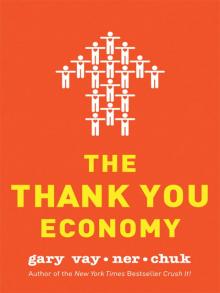 The Thank You Economy
The Thank You Economy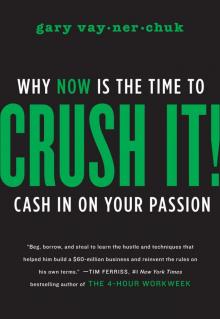 Crush It!
Crush It!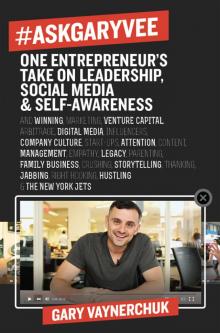 #AskGaryVee
#AskGaryVee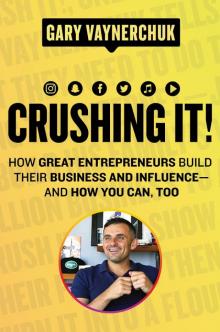 Crushing It! EPB
Crushing It! EPB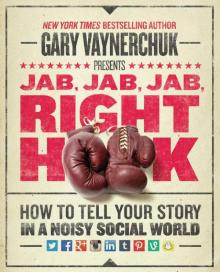 Jab, Jab, Jab, Right Hook
Jab, Jab, Jab, Right Hook